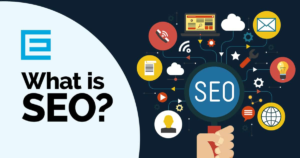Search engine optimization (SEO) is the process of creating relevant and helpful content to attract targeted traffic from search engines. It is a critical component of digital marketing and has a direct impact on business results.
Understanding SEO is important for any digital marketer. Learn about the different elements that make up seo to improve your own strategies. Click the https://www.rankboss.com/ to learn more.

Keywords are the terms people type into search engines to discover content, also known as “search queries.” They’re vital for SEO because they help you understand what your audience is searching for. And that’s the first step to creating content that connects with them.
A well-researched and carefully chosen set of keywords is essential for a comprehensive SEO strategy. In the past, it was possible to rank highly on SERPs by keyword stuffing or hitting a certain level of “keyword density.” But search engine algorithms have evolved, and you now need to ensure that your content aligns with user intent.
Keyword research involves a process of brainstorming and selecting keywords that are relevant to your business. The most important thing is to identify the search terms that are most likely to result in traffic, ideally traffic that converts. Once you have your list of keywords, you can then begin to refine it and prioritize optimisation based on the potential for traffic growth.
You’ll want to mix head terms, which are short, high-volume, and highly competitive (such as “shoes” or “coffee”) with long-tail keywords, which are more specific phrases that reflect intent more clearly (for example, “best shoes for flat feet” or “organic coffee beans in Ethiopia”). Long-tail keywords tend to have less competition than broad head terms, and they’re also more likely to convert.
After you’ve narrowed down your list of keywords, make sure that there aren’t any existing pages on your site that are targeting them. This will prevent “keyword cannibalization,” in which multiple pages on your site compete against each other for ranking. You can check for this by performing a site search with the “site” operator in Google Search.
Once you’ve created your keyword list, it’s important to test them against your site and competitors’ sites to see how effective they are. This can be done using any number of tools, including Moz’s Keyword Explorer, AnswerThePublic, and LSIGraph. In addition, you should also perform a competitor analysis to learn what they’re targeting and how to improve your own performance.
Content
Content in SEO involves creating high-quality, search engine optimized content that resonates with human readers and addresses their questions and needs. This type of content is important for increasing website traffic and converting visitors into customers.
Writing for SEO requires a special skill set that is different from regular writing. It includes the use of keywords and a thorough understanding of how search engines operate. It is also important to consider the audience and the goals of the site when writing for SEO.
The types of content in SEO can vary from blog posts to product pages and interactive tools. In addition, it is critical to optimize the content for the target keyword and provide valuable information that is not available elsewhere.
To maximize the effectiveness of your content, be sure to include relevant keywords in the title and description. This will help search engines better understand what your content is about and give it a higher ranking in the results page.
A well-optimized post should include a title tag that is unique and descriptive. It should also have a meta description that is limited to 160 characters and provides a general breakdown of the topic. This will encourage users to click on the post, which will increase the chances of a conversion.
Long-form articles are a popular form of content in SEO because they provide more detailed insights into the subject matter. They are also easier for search engines to analyze, and they can be a great source of backlinks. However, writing long-form content can be difficult because it is time-consuming and labor intensive.
In addition to written content, other forms of content in SEO are videos and visuals. These types of content are effective in SEO because they can reach and engage users with their unique formats. They can also be used to boost user engagement and dwell time on a website.
While a video may seem like an out-of-the-box idea, it can actually be an excellent tool for SEO. YouTube and other video-based social media platforms offer a wealth of opportunities for businesses to reach and connect with their audiences. Additionally, video is a highly effective way to drive traffic to your website and convert users into paying customers.
Images
Images are a great way to add context and visual appeal to a website or page. They also help strengthen keyword signals and improve user experience. When used effectively, images can drive traffic and conversions. Additionally, image SEO is important because Google displays images in a variety of places on search engine results pages (SERPs), including favicons, SERP thumbnails and featured snippets.
Images can be optimized by using descriptive alt text and a logical file name structure. The alt text should accurately describe the image and include relevant keywords. This helps both search engines and visually impaired users. In addition, the alt text should be short and concise. Keywords should be used naturally and without over-using them, as this may result in the search engine labeling your content as spam.
The file name should be a descriptive and unique name that is easy for search engines to read. Avoid using underscores or hyphens, as these are not recognized by search engines. The description should include a call to action, such as “Click here to learn more” or “Visit our Facebook Page”. It is important to ensure that your images are not too large, as this can slow down page load time. Additionally, it is important to optimize your images for web use by reducing their file size and optimizing them for viewports.
You should also make sure your images are properly tagged to help search engines understand the content of your site and find it more easily. This is particularly important if you have a mobile-friendly website, since Google uses a mobile first indexing algorithm for its crawlers. You can also optimize your images by using the picture> and srcset> attributes in your HTML code to specify responsive image formats for different screen sizes. This will allow Google to select the best version of your image for each user based on their device and screen size. This will improve your ranking in both search and image search results. Additionally, you can use image resizing tools to automatically reduce the file size of your images for quicker download times.
Backlinks
Backlinks are one of the most important factors in SEO. They help Google determine how relevant and trustworthy your content is, which in turn affects your search engine rankings. However, they’re not the only factor; other things such as keyword research and on-page optimization are also essential. The key is to build quality backlinks from trusted sources.
To improve your chances of getting high-quality backlinks, focus on creating valuable content and fostering relationships with other webmasters. You’ll want to avoid spamming and other black-hat techniques, which can hurt your SEO efforts and lead to a Google penalty. For example, if you use automated software to create backlinks or place them in forum comments, this can be considered link manipulation and can get you banned from the Google index.
You can use a backlink analysis tool to find out what kinds of backlinks are helping your competitors rank higher in search results. Some tools will display the number of links, their anchor text, and their destination URLs. They will also provide details about the website and its owner, such as domain authority (also known as domain rating). While domain authority isn’t a direct ranking factor, it can give you an idea of how competitive your site is in its industry.
In addition to their role in SEO, backlinks can also be helpful for increasing traffic to your website. For instance, if a popular website recommends your article or page, they might include it in their list of recommendations or in a blog post. Alternatively, they may choose to include it in their resources section. These types of backlinks can help drive traffic to your website and boost your brand awareness.
In order to get high-quality backlinks, you need to produce quality content that is relevant and authoritative. For example, if you write a blog post about sneaker trends, you should try to get a link from a related website. Irrelevant backlinks can actually hurt you, as Google tries to reduce their impact in its SERP algorithms.
